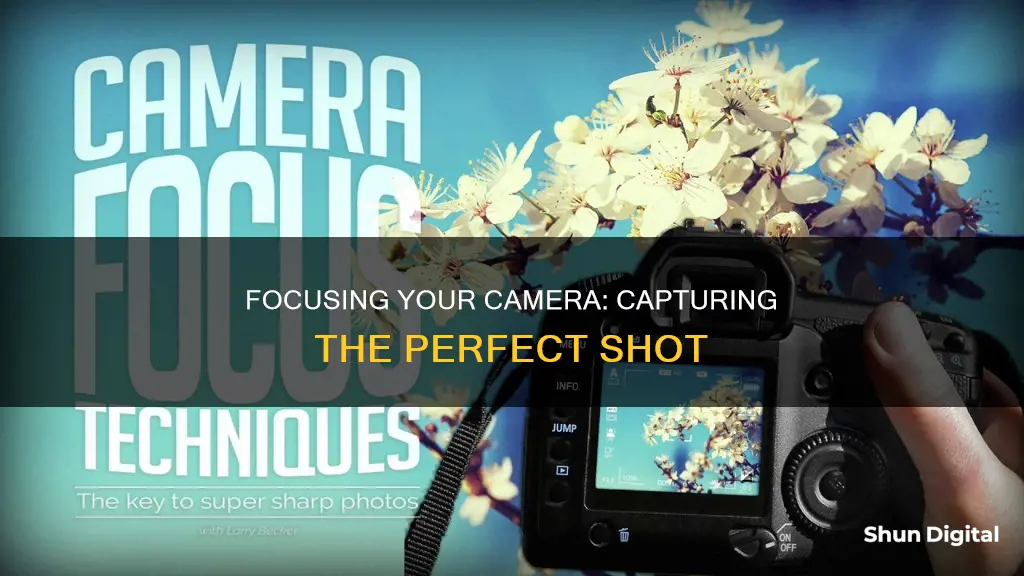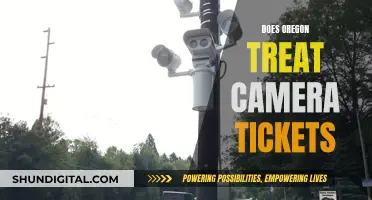
Focusing a camera is a critical skill in photography and videography. The focus of a camera is the region in space with the potential to be as sharp as possible in a photo. The plane of focus can be moved forward and backward, usually with the subject at maximum sharpness. This is called focusing.
Modern cameras focus automatically or manually. Manual focus involves turning a ring or similar mechanism on the lens. Automatic focus, on the other hand, involves a motor in the camera or lens that focuses on a subject selected manually or automatically.
When focusing manually, you can locate the focus control, usually a manual focus ring near the front of the lens housing, and adjust the focus ring until the picture is sharp. Turning the ring clockwise focuses on closer objects, while turning it anti-clockwise focuses on more distant objects.
The aperture setting also affects the focus. A wider aperture results in a shallower depth of field, while a narrower aperture results in a deeper depth of field. The focus distance that the lens is set to also matters—the closer you focus, the narrower the depth of field will be.
Additionally, the type of camera and lens can impact focusing. DSLR cameras typically use phase detection autofocus, which is fast and good for tracking moving subjects but prone to errors. Mirrorless cameras, point-and-shoot cameras, and DSLR cameras in live view typically use contrast detection autofocus, which is slower but more precise.
Finally, some tips for focusing include focusing on your main subject, such as a person's eyes, or focusing on unexpected areas to draw attention to a specific part of your photo. You can also use autofocus modes like single-point autofocus, dynamic autofocus, and group-area autofocus to assist with focusing on your subject.
| Characteristics | Values |
|---|---|
| Camera focus | Manual focus, autofocus |
| Autofocus | Phase detection, contrast detection |
| Manual focus | Focus ring |
| Autofocus area modes | Single-point, dynamic, 3D tracking, group-area, auto-area |
What You'll Learn

Manual vs Autofocus
Modern cameras are equipped with autofocus systems that can be tailored to all kinds of scenes and subjects. However, photographers can also choose to focus manually. Both autofocus and manual focus have their advantages and disadvantages, and the decision to use one over the other depends on the specific situation and the photographer's preferences.
Autofocus
Autofocus (AF) is a camera feature that automatically adjusts the lens to obtain focus on the subject. AF systems use either contrast sensors within the camera (passive AF) or emit a signal to estimate the distance to the subject (active AF). While AF is generally quick and convenient, it has some limitations.
Advantages of Autofocus:
- AF systems are generally very fast and can focus on moving objects, making them ideal for action photography or sports scenes.
- They require less user intervention, allowing photographers to concentrate on other aspects of the shot, such as composition or lighting.
- Modern AF systems have improved low-light performance and can focus in dimly lit environments.
Disadvantages of Autofocus:
- AF relies on contrast to identify objects, and in low-contrast or backlit scenes, it may struggle to lock focus.
- In scenes with multiple objects, AF may focus on the wrong object, especially if it is confused by foreground elements.
- Autofocus can struggle with magnified or macro photography, as it finds it challenging to determine the object of focus at high magnifications.
Manual Focus
Manual focus gives the photographer complete control over the focus point. It is typically adjusted using a ring around the lens or a control on the camera body. While it requires more skill and time, manual focus offers several benefits.
Advantages of Manual Focus:
- Manual focus is ideal for low-contrast scenes, low-light conditions, or situations where the subject is visually similar to its surroundings, as it does not rely on the camera's ability to detect contrast.
- It is useful when shooting through obstructions like glass or fences, as it prevents the camera from focusing on the wrong object.
- Manual focus is excellent for precision work, such as portraits or macro photography, where the focus point needs to be exact.
- It is better suited for video shooting, as it allows for smooth transitions between focus points and eliminates the noise of focusing motors.
Disadvantages of Manual Focus:
- Manual focus requires more time and skill to execute correctly, especially when capturing moving subjects.
- It may not be as fast as autofocus, making it less suitable for action or sports photography.
- In some situations, manual focus can be more confusing, especially when the photographer is still learning how to use it effectively.
Both autofocus and manual focus have their strengths and weaknesses. Autofocus is generally faster and more convenient, making it suitable for action shots and scenes with moving objects. On the other hand, manual focus provides greater control and precision, excelling in low-contrast lighting, macro photography, and video shooting. Ultimately, the choice between the two depends on the specific photographic situation and the photographer's creative vision.
Traffic Camera Tickets in Pennsylvania: What You Need to Know
You may want to see also

Phase Detection vs Contrast Detection
When it comes to autofocus technology in modern digital cameras, there are two systems: phase detection autofocus (PDAF) and contrast detection autofocus (CDAF). Both have their pros and cons, but PDAF is generally preferred by photographers due to its speed and accuracy. However, the best autofocus system depends on the type of photography, the camera used, and personal preference.
Phase Detection Autofocus
PDAF uses two sensors located on each side of the camera lens to detect the phase difference of the light entering the lens. This allows the camera to determine if the subject is in focus and adjust the lens accordingly. Phase detection autofocus is typically found in digital SLRs and some mirrorless cameras. It is more modern and relies on specific sensor technology that reads information entering the lens as in phase or out of phase. This autofocus system is much faster than contrast detection but usually requires more technology inside the camera, resulting in a larger size and higher cost.
Contrast Detection Autofocus
CDAF, on the other hand, uses the camera's sensor to detect the contrast between light and dark areas in the scene. The camera's processor then analyses the information from the image sensor and adjusts the lens to bring the subject into focus. Contrast detection autofocus is most commonly used in mirrorless cameras and some point-and-shoot cameras. It is arguably more accurate than phase detection, especially when focusing on stationary subjects, making it ideal for portrait and landscape photography. Additionally, this autofocus system is quieter, making it suitable for photographing skittish animals or in quiet environments.
Hybrid Autofocus
With advancements in camera technology, some mirrorless cameras now offer a hybrid autofocus system that combines both PDAF and CDAF. This hybrid system can track moving subjects using phase detection sensors and focus on stationary subjects with contrast detection, providing greater control and flexibility for photographers.
Choosing the Right Autofocus System
The choice between phase detection and contrast detection autofocus depends on the specific needs of the photographer and the type of subjects they are shooting. Phase detection is ideal for capturing moving subjects, such as in sports and action photography, due to its speed and continuous tracking capabilities. In contrast, contrast detection is better suited for stationary subjects, such as portrait, landscape, and still life photography, as it provides more accurate focus.
Mastering Camera Lock Modes in League of Legends
You may want to see also

Continuous vs Single-Servo Autofocus
Single-servo autofocus and continuous autofocus are two of the main autofocus modes available on most professional cameras. They are also referred to as single autofocus and continuous autofocus.
Single-servo autofocus is best used for static scenes or subjects that are not moving. When you half-press the shutter button, the camera will focus on the subject and lock on to it. The focus will stay locked until you take your finger off the button or fully depress it to take the photo. This mode is useful when motion is not a major factor and when the depth of field is not critically shallow.
Continuous autofocus, on the other hand, is ideal for shooting moving subjects. In this mode, the camera tracks the subject's movement and continually adjusts the focus to keep the subject sharp. This is done by continuously measuring the distance between the camera and the subject. The focus will keep changing as long as you keep the shutter button half-pressed or until you release it to take the shot. Continuous autofocus is also useful when shooting at super-shallow apertures and close distances, as even the slightest movement can throw the subject out of focus.
It is worth noting that some cameras have a third autofocus mode called automatic autofocus, which switches between single and continuous autofocus depending on the movement of the subject.
Eufy Camera Origins: Where Are They Manufactured?
You may want to see also

Autofocus Area Modes
There are several autofocus area modes available, each with its own advantages and disadvantages. Here are some of the most common autofocus area modes:
- Single-Point AF Area Mode: This mode allows you to select a single focus point for static elements within the scene. The camera will automatically adjust the focus to keep the image sharp as long as the subject remains framed over the selected point.
- Dynamic AF Area Mode: This mode is ideal for moving subjects. You manually select the initial focus point, and the camera will use this point and the surrounding points to keep the subject in focus as it moves.
- Group AF Area Mode: This mode is useful when you want to focus on a specific area with a small number of autofocus points. It is often used in wildlife and sports photography when there are multiple subjects in a group.
- Auto AF Area Mode: This mode is fully automatic and allows the camera to decide which focus points to use based on the scene. It is useful for novice photographers or when you need to focus quickly on something close to the camera.
- Pinpoint AF Mode: This mode is designed to use contrast detection autofocus to focus precisely on a small portion of the scene. It is only available in AF-S mode and is useful for stationary subjects such as landscapes and architecture.
Different camera brands may have different names for the same autofocus area modes. For example, Single-Point AF Area Mode is called "Manual AF Point" on Canon cameras and "Center/Flexible Spot" on Sony cameras. It is important to refer to your camera's instruction manual to understand the specific autofocus area modes available on your device.
Understanding Camera Shooting Modes: A Beginner's Guide
You may want to see also

Active vs Passive Autofocus
There are two types of autofocus (AF) systems: Active and Passive. The "Active AF" system works by emitting a red beam of light onto the subject, then bouncing that light back to the camera to calculate the distance between the camera and the subject. The camera then instructs the lens to adjust its focus based on this information. Active AF is useful in low-light environments and for stationary, non-moving subjects. However, it is only effective for close subjects.
On the other hand, the "Passive AF" system works very differently. Instead of relying on a red beam, it uses Phase Detection or Contrast Detection or a combination of both for detecting contrast. Many compact digital cameras and smartphones rely solely on Contrast Detection AF, while most modern DSLR and mirrorless cameras can use both Phase and Contrast Detection to acquire focus.
Phase Detection AF uses an array of microlenses for focusing. As light passes through these microlenses, it splits into a pair of images, and the distance between these images is measured to determine whether the subject is in front or back focus. This information is then used to adjust the lens focus accordingly. Phase Detection AF is known for its speed, making it ideal for tracking fast-moving subjects.
Contrast Detection AF, on the other hand, relies on software algorithms that scan areas of an image for edge detail. The camera rapidly changes focus from foreground to background until the subject is perfectly sharp. Contrast Detection AF is generally slower but can be more reliable and accurate in low-light conditions.
Some cameras combine both Phase and Contrast Detection AF, known as "Hybrid AF," to take advantage of the benefits of each system in different environments.
Yi Lite Action Camera: How Long Does the Battery Last?
You may want to see also
Frequently asked questions
Focus on the person's eyes so they are clear.
Focus on an object that is far away from the camera.
Use continuous-servo autofocus mode. This will continuously adjust focus whenever you hold down the focusing button.







